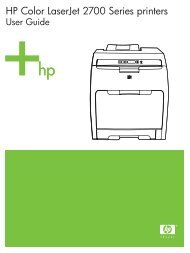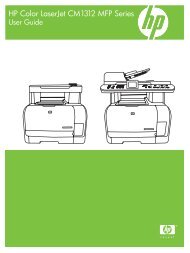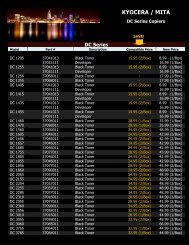HP LaserJet M1005 MFP user guide - ENWW
HP LaserJet M1005 MFP user guide - ENWW
HP LaserJet M1005 MFP user guide - ENWW
You also want an ePaper? Increase the reach of your titles
YUMPU automatically turns print PDFs into web optimized ePapers that Google loves.
Problem Cause Solution<br />
Black dots or streaks<br />
appear on the copy.<br />
Copies are too light or<br />
dark.<br />
Ink, glue, correction fluid, or an<br />
unwanted substance might be on the<br />
flatbed scanner.<br />
The printer driver or device settings<br />
may be incorrect.<br />
Text is unclear. The printer driver or device settings<br />
may be incorrect.<br />
Media-handling problems<br />
Problem Cause Solution<br />
Poor print quality or<br />
toner adhesion<br />
Dropouts, jamming, or<br />
curl<br />
The paper is too moist, too rough,<br />
too heavy or too smooth, or it is<br />
embossed or from a faulty paper lot.<br />
The paper has been stored<br />
incorrectly.<br />
The paper has variability from one<br />
side to the other.<br />
Excessive curl The paper is too moist, has the<br />
wrong grain direction, or is of shortgrain<br />
construction.<br />
Jamming, damage to<br />
device<br />
Clean the device. See Cleaning the device.<br />
Verify that the quality settings are correct. See Adjusting<br />
the copy quality.<br />
Verify that the quality settings are correct. See Adjusting<br />
the copy quality.<br />
Try another kind of paper, between 100 and 250<br />
Sheffield, 4 to 6% moisture content.<br />
Store paper flat in its moisture-proof wrapping.<br />
Turn the paper over.<br />
The paper varies from side-to-side. Turn the paper over.<br />
Use long-grain paper, or use the Less paper curl<br />
setting. See Reducing paper curl.<br />
The paper has cutouts or perforations. Use paper that is free of cutouts or perforations.<br />
Problems with feeding The paper has ragged edges. Use high-quality paper that is made for laser printers.<br />
The paper varies from side-to-side. Turn the paper over.<br />
The paper is too moist, too rough,<br />
too heavy or too smooth, has the<br />
wrong grain direction, or is of shortgrain<br />
construction or it is embossed<br />
or from a faulty paper lot.<br />
Print is skewed (crooked). The media <strong>guide</strong>s might be<br />
incorrectly adjusted.<br />
Try another kind of paper, between 100 and 250<br />
Sheffield, 4 to 6% moisture content, or use long-grain<br />
paper.<br />
Remove all media from the input tray, straighten the<br />
stack, and then load the media in the input tray again.<br />
Adjust the media <strong>guide</strong>s to the width and length of the<br />
media that you are using and try printing again.<br />
94 Chapter 9 Problem solving <strong>ENWW</strong>






